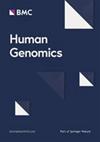The cryptic complex rearrangements involving the DMD gene: etiologic clues about phenotypical differences revealed by optical genome mapping
IF 3.8
3区 医学
Q2 GENETICS & HEREDITY
引用次数: 0
Abstract
Deletion or duplication in the DMD gene is one of the most common causes of Duchenne and Becker muscular dystrophy (DMD/BMD). However, the pathogenicity of complex rearrangements involving DMD, especially segmental duplications with unknown breakpoints, is not well understood. This study aimed to evaluate the structure, pattern, and potential impact of rearrangements involving DMD duplication. Two families with DMD segmental duplications exhibiting phenotypical differences were recruited. Optical genome mapping (OGM) was used to explore the cryptic pattern of the rearrangements. Breakpoints were validated using long-range polymerase chain reaction combined with next-generation sequencing and Sanger sequencing. A multi-copy duplication involving exons 64–79 of DMD was identified in Family A without obvious clinical symptoms. Family B exhibited typical DMD neuromuscular manifestations and presented a duplication involving exons 10–13 of DMD. The rearrangement in Family A involved complex in-cis tandem repeats shown by OGM but retained a complete copy (reading frame) of DMD inferred from breakpoint validation. A reversed insertion with a segmental repeat was identified in Family B by OGM, which was predicted to disrupt the normal structure and reading frame of DMD after confirming the breakpoints. Validating breakpoint and rearrangement pattern is crucial for the functional annotation and pathogenic classification of genomic structural variations. OGM provides valuable insights into etiological analysis of DMD/BMD and enhances our understanding for cryptic effects of complex rearrangements.涉及 DMD 基因的隐性复合重排:光学基因组图谱揭示的表型差异的病因学线索
DMD 基因的缺失或重复是导致杜兴氏和贝克氏肌营养不良症(DMD/BMD)的最常见原因之一。然而,涉及 DMD 的复杂重排,尤其是断点不明的节段性重复,其致病性尚不十分清楚。本研究旨在评估涉及 DMD 重复的重排的结构、模式和潜在影响。研究人员招募了两个表现出表型差异的 DMD 节段重复家族。利用光学基因组图谱(OGM)探索重排的隐性模式。利用长程聚合酶链反应结合新一代测序和桑格测序验证了断点。在家族 A 中发现了涉及 DMD 64-79 号外显子的多拷贝重复,但无明显临床症状。家族 B 表现出典型的 DMD 神经肌肉症状,并出现涉及 DMD 第 10-13 号外显子的重复。A 家系的重排涉及 OGM 显示的复杂顺式串联重复,但保留了断点验证推断的 DMD 的完整拷贝(阅读框)。在 B 家系中,OGM 发现了一个带有片段重复的反向插入,在确认断点后,预测该插入会破坏 DMD 的正常结构和阅读框。验证断点和重排模式对于基因组结构变异的功能注释和致病性分类至关重要。OGM 为 DMD/BMD 的病因分析提供了有价值的见解,并增强了我们对复杂重排隐性效应的理解。
本文章由计算机程序翻译,如有差异,请以英文原文为准。
求助全文
约1分钟内获得全文
求助全文
来源期刊

Human Genomics
GENETICS & HEREDITY-
CiteScore
6.00
自引率
2.20%
发文量
55
审稿时长
11 weeks
期刊介绍:
Human Genomics is a peer-reviewed, open access, online journal that focuses on the application of genomic analysis in all aspects of human health and disease, as well as genomic analysis of drug efficacy and safety, and comparative genomics.
Topics covered by the journal include, but are not limited to: pharmacogenomics, genome-wide association studies, genome-wide sequencing, exome sequencing, next-generation deep-sequencing, functional genomics, epigenomics, translational genomics, expression profiling, proteomics, bioinformatics, animal models, statistical genetics, genetic epidemiology, human population genetics and comparative genomics.
 求助内容:
求助内容: 应助结果提醒方式:
应助结果提醒方式:


